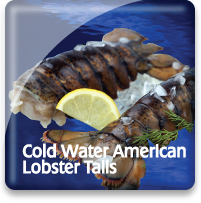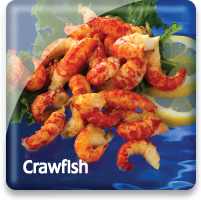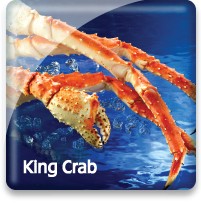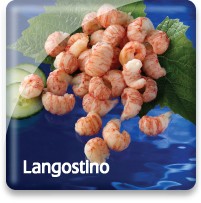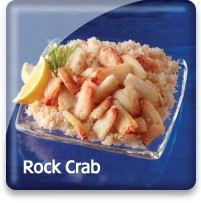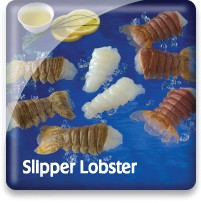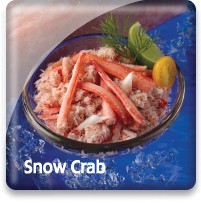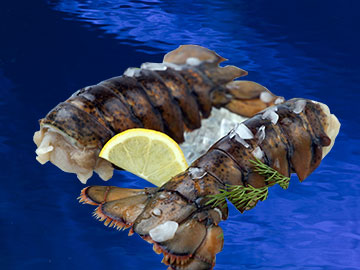
Cold Water American Lobster Tails

Market Name: Eating QualitiesAmerican Lobster is very rich flavored with both brilliant white and red-highlighted colored firm meat.
American Lobsters are the largest lobsters growing up to 40 pounds.
|
Description & CharacteristicsAmerican Lobsters, also called Maine, Canadian, Northern, or Atlantic Lobsters, are categorized as being cold water lobsters. They inhabit both the nearshore and offshore waters of the Northwestern Atlantic Ocean stretching from Labrador, Canada to North Carolina in the United States. Both Canadian and American fishery authorities sustainably manage American Lobsters. They are contrasted with spiny warm water lobsters from the tropics by possessing two large front claws and having sweeter and firmer meat. American Lobsters are caught using traps (pots) that are baited with primarily herring and submerged on the ocean floor at depths between 10-200 feet for the nearshore fisheries to over 2000 feet for the offshore continental shelf fisheries. The average time traps remain on the ocean floor is between 2-5 days. The offshore season is generally year round while some Canadian nearshore fisheries are closed from July through September to protect molting and reproducing lobsters. However, most lobstermen fish year round only stopping due to harsh winter weather and then resume fishing in the spring. The American Lobster is among the largest of all marine crustaceans, sometimes growing to lengths of two feet and weighing over 40 pounds. They grow by a process called molting in which they shed their shell as they get larger and replace it with a new shell. Molting may occur more than once a year. They live longer than any other lobster reaching up to 50 years old. They migrate seasonally in response to the change in ocean temperatures. They head toward shallow waters in the spring and summer to molt (allowing females to mate), reproduce, hatch eggs and then return to deeper waters in the fall. The movement or migrations of adult lobsters can be extensive and cover long distances. American Lobsters mature at around 6-8 years old. For most female lobsters, the eggs will be laid the year after mating and not hatch for up to another year! This makes it a two-year mating cycle for females. This means that the sperm from mating are carried for about one year and then they fertilize the eggs when the female extrudes them as they become attached to the underside of her tail by a sticky glue-like substance. The females then carry their attached fertilized eggs for up to another year until they are finally hatched as free-floating larvae. Within 3-12 weeks, these free-floating larvae settle to the ocean floor to seek shelter in rocky areas allowing them to further transform into juvenile lobsters. With each successive mating cycle, females are able to produce more and more eggs (up to 150,000). Because of this fecundity trait, there are strict fishing regulations and traditions in both Canada and the U.S. that prohibit the harvesting of most females and especially the larger and older ones. In addition, larger males are also released in order to be available to mate. Females must also be released from traps if they are carrying eggs or are marked with a “v-notch” on their tail flipper. The “v-notch” is made by a lobsterman who traps a first-time egg-bearing female. This “v-notch” is harmless, lasts about 5 years, and is designed to inform other lobstermen that may re-catch this female that she has been fertile in the past and must be released. This historical management practice has essentially relegated the lobster fishery to landing only medium sized males and females. However, this has contributed to the long-term success of the American Lobster fishery for decades. Recently, the combined total annual catch of American Lobsters from Canada and the U.S. reached an all-time record of around 300 million pounds. The landings have more than doubled over the past 20 years by exhibiting steady grown. This growth is due to historically responsible fishery management practices and traditions. However, this increase may also be due to environmental changes such as warming oceans and/or a decrease in lobster predation throughout its life cycle stages (possibly due to dwindling cod and other groundfish stocks). Going forward, ocean warming may trend even higher so both Canadian and U.S. lobster fishery management plans should be flexible to account for both possible changes in lobster migration patterns and productivity. Most of the American Lobsters are sold to the United States, Europe, and Asia as hard-shell live lobsters that are several months past their last molt and therefore able to survive shipping and handling stresses. Lobsters that have softer shells due to the molting cycle cannot survive shipping or extended handling so their meat is extracted from their claws, tails, and legs and sold either cooked or raw to primarily the United States and Europe in the fresh and frozen form. Frozen single tails are also gaining popularity in both retail and foodservice. Regardless of the multiple marketing forms of the American Lobster, they are all wonderful culinary delights that should be enjoyed as part of your healthy seafood diet. Other Resources |
Handling Instructions for Cold Water Lobster Tails
Our raw cold water lobster tails should be stored at or below 0°F (-18°C) and then thawed properly when ready to cook. The frozen shelf life is 24 months. Links to proper seafood handling instructions: NOAA - Fish Watch: Handling Seafood and A Consumer Guide to Safe Seafood Handling.
Thawing Cold Water Lobster Tails
Cold water lobster tails should be thawed in a sealed plastic container or bag and placed under refrigeration (33-39°F) for 12-24 hours or until completely thawed. Quick thawing can be accomplished by placing them in a colander and running them under cold water for 8-12 minutes or by placing them in a plastic bag and submerging them in a cold water bath until completely thawed (12-20 minutes). Thawed lobster tails should be held at 33-39°F and totally consumed within 2-3 days.
Important Instructions for Cold Water Lobster Tails
The Federal Food, Drug and Cosmetic Act now requires that all foods that are not raw agricultural commodities and that contain a major food allergen be labeled to clearly identify the name of the food source form which the allergen is derived. (21 CFR U.S.C. 343(w)(1)). The act defines eight foods, and any ingredients derived from these foods as major food allergens: Fish, Crustacean Shellfish, Milk, Eggs, Tree Nuts, Peanuts, Wheat & Soybeans. The name of the food source that must be listed on the label for fish or crustacean shellfish must be the specific type of fish or crustacean shellfish. The market names of species of fish and crustacean shellfish should be used to identify the food source of these two major food allergens. If you intend to re-pack these seafood products, be sure the allergen is declared in either one of two ways:
1) Within the list of ingredients
or
2) In a separate “Contains” statement immediately after or adjacent to the list of ingredients.
Consult the Fish and Fishery Products Hazards and Controls Guidance, Fourth Edition, Chapter 19 for more detailed information on the labeling of food allergens.
Cooking Tips
Care must be taken to not overcook lobster. However, even slightly overcooked lobster is a wonderful taste treat! Links to recipes: Buying Frozen Lobster Tails - How To Thaw Frozen Lobster Tails - Cooking Frozen Lobster Tails, How to Cook Lobster Tails.
The United States
The United States of America has over 95 thousand miles of coastline, ranks fourth in the world in wild capture fisheries and thirteenth in aquaculture production. The wild capture fisheries is dominated by Alaska pollock and followed by menhaden, salmon, flatfish, and cod. After these wild caught finfish species which comprise 84% of the entire wild catch, the remaining capture fisheries primarily consist of crab, shrimp, and shellfish. Aquaculture production in the U.S. is comprised of roughly 70% freshwater and 30% marine farms. Freshwater aquaculture is dominated by catfish and followed by trout production while the marine aquaculture in comprised of 65% shellfish (clams, oysters, & mussels), 25% salmon, and 10% shrimp. At present, aquaculture represents 5% of the total U.S. seafood production. The long term sustainability of U.S. wild fisheries has been the goal of the 1976 Magnuson-Stevens Act. The National Marine Fisheries Service manages all activities to achieve this goal and at this time the majority of wild capture fisheries in the U.S. are sustainable. In 2011 the U.S. Department of Commerce and the National Oceanic and Atmospheric Administration released policies that promote the accelerated development of marine aquaculture. Both wild fisheries and aquaculture in the United States are currently well managed for sustainable growth.
Canada
Canada is almost a carbon copy of the United Sates in terms of land mass and miles of coastline. This makes Canada very similar to the United Sates in terms of fishery resources with the exceptions of the U.S. warm water fisheries along the Gulf coasts and Hawaii. Canada’s wild fishing industry operates on the Atlantic and Pacific coasts, and on more than 800 freshwater lakes in between. The country exploits more than 100 commercially valuable species of fish. The top wild species caught are hake, ocean perch, cod, herring, salmon, capelin, cold water shrimp, snow crab, rock crab, lobster, halibut, and scallops. Canada’s aquaculture production is growing and is primarily comprised of salmon, steelhead, mussels, oysters, scallops, trout, Arctic char, with additional progress being made with black cod, halibut, haddock, eel, tilapia, sea urchin, quahog clams, and geoduck clams. Canada has strong nationwide fishery and aquaculture management in place to help advance their sustainable development.
Go Blue! Seafood Sustainability Spectrum*Click here for an explanation of our Sustainability Spectrum

Sustainability AssessmentSea Port sources American Lobster from both Canada and the U.S. There are four major stocks designated in Canada and three major stocks in the U.S. that comprise both nearshore and offshore fisheries. The Department of Fisheries and Oceans in Canada that manages Canadian stocks and the Atlantic States Marine Fisheries Commission in cooperation with the National Marine Fisheries Service that manages U.S. stocks have very similar management schemes designed for sustaining the American Lobster fisheries.
For roughy the past 20 years, these two nations have maintained harvests that has been stable to even increasing in recent years. Both the Marine Stewardship Council (MSC) and the Monterey Bay Aquarium’s Seafood Watch programs have determined that most Canadian and U.S. American Lobster fisheries are sustainably managed.
Environmental Impact: Low to ModerateAmerican Lobsters are currently abundant throughout most of their range. Both Canadian and U.S. management schemes of restricting the harvest of most females, regulating lobster sizes that can be landed, and regulating fishing areas and seasonality, and trap (pot) specifications that reduce unwanted bycatch and mitigate the damage caused by lost traps have resulted in a fishery that has low negative benthic habitat and ecosystem impacts along with low interaction with seabirds, other fisheries, and threatened/endangered species.
Sustainability Improvements NeededThe vertical buoy lines of American Lobster traps can entangle endangered Right Whales, Humpback Whales, and sea turtles. This is an area of improvement that may warrant closing of certain areas during whale and turtle migrations and possibly creating new break-a-way lines technologies. In addition, adapting American Lobster management schemes to deal with rapidly warming ocean temperatures would be prudent as there is evidence that the southernmost stocks have started to trend downward and this warming could be causative.
Actions that Sea Port is UndertakingSea Port supports this fishery and by doing so will help advance the environmental sustainability of this well managed fishery. This well managed wild American Lobster fishery adds another sustainable and responsibly produced seafood to a growing variety of seafood choices that will help sustain the health of both humans and the planet’s ecosystems. Sea Port believes that, in aggregate, choosing from a diverse variety of seafood is better for sustaining the world’s seafood resources and that American Lobster should be a part of this variety. We created the sustainability assessments for each of our seafood items in order to reveal the existing and potential environmental impacts and risks that are associated with producing them for human consumption. This allowed us to establish the starting position for each of our seafood items along our progressive Go Blue! Seafood Sustainability Spectrum®. These assessments are only a single snapshot in time and because of this, we will continue to assess and update the critical sustainability needs associated with our supply sources and issue updates to the Go Blue! Seafood Sustainability Spectrum® as needed. There is a growing global awareness for the need to assure the sustainability of farmed and wild caught seafood and because of this; all around the world positive changes are rapidly occurring at all levels of the seafood supply chain. We will continue to spread this growing awareness and work with our many industry partners to improve the sustainability of all seafood, which we believe is the ideal protein of choice to feed an ever growing world population. Our Go Blue! Seafood Sustainability Spectrum® serves as our compass and yardstick as we strive to move all our products forward to becoming more sustainable. Please join us in this committed quest and Catch Our Wave® to sustainability by choosing a diverse variety of responsibly produced seafood as part of your diet.
|


